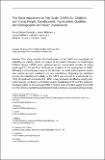Files in this item
The Short Attachment to Pets Scale (SAPS) for children and young people : development, psychometric qualities and demographic and health associations
Item metadata
| dc.contributor.author | Marsa-Sambola, Ferran | |
| dc.contributor.author | Muldoon, Janine | |
| dc.contributor.author | Williams, Joanne | |
| dc.contributor.author | Lawrence, Alistair | |
| dc.contributor.author | Connor, Melanie | |
| dc.contributor.author | Currie, Candace | |
| dc.date.accessioned | 2016-06-23T09:30:03Z | |
| dc.date.available | 2016-06-23T09:30:03Z | |
| dc.date.issued | 2016-03-01 | |
| dc.identifier | 241406068 | |
| dc.identifier | c60fa45f-cb4d-4764-af48-ce1025e1e3db | |
| dc.identifier | 84958537040 | |
| dc.identifier | 000375409300007 | |
| dc.identifier.citation | Marsa-Sambola , F , Muldoon , J , Williams , J , Lawrence , A , Connor , M & Currie , C 2016 , ' The Short Attachment to Pets Scale (SAPS) for children and young people : development, psychometric qualities and demographic and health associations ' , Child Indicators Research , vol. 9 , no. 1 , pp. 111-131 . https://doi.org/10.1007/s12187-015-9303-9 | en |
| dc.identifier.issn | 1874-897X | |
| dc.identifier.uri | https://hdl.handle.net/10023/9041 | |
| dc.description | The findings presented belong to "An investigation of 13–17 year olds’ attitudes and behaviour to animals and development and testing of interventions to promote the concept of Duty of Care" (SMDO-ZGLD15) which was funded by the Department for Environment, Food and Rural Affairs (DEFRA). | en |
| dc.description.abstract | This study describes the development of the SAPS and investigates its reliability and validity within the context of the Health Behaviour in School-Aged Children Survey (HBSC) which gathered data on representative samples of school pupils aged 11, 13 and 15 in Scotland and England. In the development of SAPS, following a comprehensive review of the literature, two small-scale empirical studies were carried out (one qualitative and one quantitative). Regarding the validation process, the reliability and validity of the SAPS was assessed in a sub-sample (n = 7159) of pupils who completed the HBSC survey and were identified as owning pets. Factor analysis resulted in a one-factor solution (explaining 67.78 % of the variance); Cronbach’s alpha for the scale was 0.894. The item-total correlation ranged from 0.368 to 0.784. A linear model showed that attachment to pets was associated with age (being 11 or 13 years old), being a girl, white ethnicity, and considering a pet as one’s own. SAPS scores were also positively associated with quality of life. The total variance in SAPS explained by these variables was 15.7 %. Effect sizes of associations were medium (age, considering a pet as one’s own) and small (ethnicity, age, gender, quality of life). The study concludes that SAPS is a coherent and psychometrically sound measure. It is associated with a range of demographic variables and quality of life, which confirms its utility as a new succinct measure of children’s and young people’s attachment to pets for use in health and social science research. | |
| dc.format.extent | 21 | |
| dc.format.extent | 232328 | |
| dc.language.iso | eng | |
| dc.relation.ispartof | Child Indicators Research | en |
| dc.subject | Attachment | en |
| dc.subject | Pets | en |
| dc.subject | Young people | en |
| dc.subject | Children | en |
| dc.subject | Health | en |
| dc.subject | H Social Sciences | en |
| dc.subject | RJ101 Child Health. Child health services | en |
| dc.subject | Health(social science) | en |
| dc.subject | Social Psychology | en |
| dc.subject | Sociology and Political Science | en |
| dc.subject | NDAS | en |
| dc.subject.lcc | H | en |
| dc.subject.lcc | RJ101 | en |
| dc.title | The Short Attachment to Pets Scale (SAPS) for children and young people : development, psychometric qualities and demographic and health associations | en |
| dc.type | Journal article | en |
| dc.contributor.institution | University of St Andrews. School of Medicine | en |
| dc.contributor.institution | University of St Andrews. Child and Adolescent Health Research Unit | en |
| dc.contributor.institution | University of St Andrews. WHO Collaborating Centre for International Child & Adolescent Health Policy | en |
| dc.identifier.doi | 10.1007/s12187-015-9303-9 | |
| dc.description.status | Peer reviewed | en |
This item appears in the following Collection(s)
Items in the St Andrews Research Repository are protected by copyright, with all rights reserved, unless otherwise indicated.

